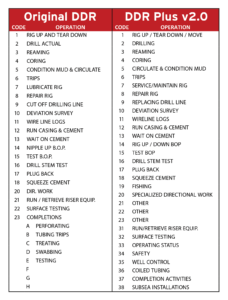Daily Drilling Report overhaul aims to provide standard framework for more detailed activity tracking
V2.0 of DDR Plus has been released to the industry following feedback received on V1.0 during 2019
By Stephen Whitfield, Associate Editor
The IADC Daily Drilling Report (DDR) is a staple of the drilling industry, the primary data-collection form for rigs around the world and a key element in determining the duration of various processes that makeup drilling, completing and intervening operations. The data collected in the DDR have remained underutilized, however, in part because of a lack of structure.

In early 2018, the IADC Advanced Rig Technology (ART) Committee launched a project to update and digitalize the DDR. The work led to an upgraded system, the DDR Plus, which is designed to be more usable for automated systems to improve accuracy and reduce reporting time.
At the 2020 IADC/SPE International Drilling Conference in Galveston, Texas, David Shackleton, Regional Manager Americas at Independent Data Services (IDS), said updating the DDR with a standardized electronic data format, or “schema,” was determined to be beneficial for the industry at large. IDS was later contracted by IADC to develop the schema for DDR Plus.
“The DDR hadn’t been significantly updated over decades,” Mr Shackleton said. “It had been tweaked here and there to add and remove things, but it hadn’t really been updated, and it wasn’t fit-for-purpose in this century. Opportunities were being lost to integrate, so there was a feeling that we had to put a brisk pace in finishing this program.”
The IADC ART Data, Controls and Sensors (DCS) Subcommittee first created a survey in early 2018 to solicit ideas about potential updates to the DDR. The survey asked respondents, among other things, to outline how they used the DDR and the things they would like to see from the update.
Throughout the development process, the subcommittee considered the feedback that was received from this survey, as well as the need to ensure that the new system would be backwards compatible for all users.
One key finding from the survey was that DDR users wanted the ability to log activities in greater detail. “Users weren’t happy that they couldn’t express all of the activities from the equipment being used. They couldn’t get everything they wanted to on to the reports” Mr Shackleton said.
To achieve this, codes for activity, sub-activity, equipment, sub-equipment and company were created. The industry was asked to contribute to this effort by sharing their own code sets to help ensure the completeness of these standard IADC codes.

During the overhaul process, minor changes were also made to the main code names to improve clarity. Two examples are changing Code 2 from “Drill Actual” to “Drilling” or Code 14 from “Nipple Up BOP” to “Rig Up/Down BOP.”
Mr Shackleton said the DDR Plus structure should provide users the flexibility to mold new DDR codes to their own sets while remaining compatible with the new DDR Plus. The granular code set will encourage more detailed reporting and analytics.
The survey responses also had pointed to the desire for a standard digital description. Over the years, IADC-licensed electronic data reporting companies and various drilling contractors had digitized the DDR using their own methods, creating various electronic DDRs that mimic the paper version. However, it’s recognized that an industry standard digitalized version could enable a consistent method for collecting and transferring data from one database to another.
Mr Shackleton said survey responses on standardization showed a willingness within the industry to collaborate – with 86% of respondents indicating that they supported standardized data entry.
“A standard way means it is much easier to collaborate with different companies,” he said. “This is getting pretty advanced. The survey was proof that the industry is willing to collaborate and that they want to automate things. The industry was not happy with retyping data and estimating times. They want to use the real data to get these reports accurate.”
The DCS Subcommittee used an XML (extended markup language) format to standardize the digital description of the DDR Plus. The WITSML data exchange standard was chosen as a markup language.
The DDR Plus structure should provide users the flexibility to mold new DDR codes to their own sets while remaining compatible with the new DDR Plus. The granular code set will encourage more detailed reporting and analytics.
Mr Shackleton said the standardization of the DDR Plus’ digital description will make for simpler data flow. Service companies can standardize the way they send data to drilling contractors, and contractors can expect service companies to use the standardized schema to deliver the digital description of the service they are providing.
The DDR Plus codeset is available now electronically; companies that are not current licensees of the IADC system can send an e-mail to Bookstore@iadc.org for more information. The DDR Plus in paper format is scheduled to become available later in 2020. DC





